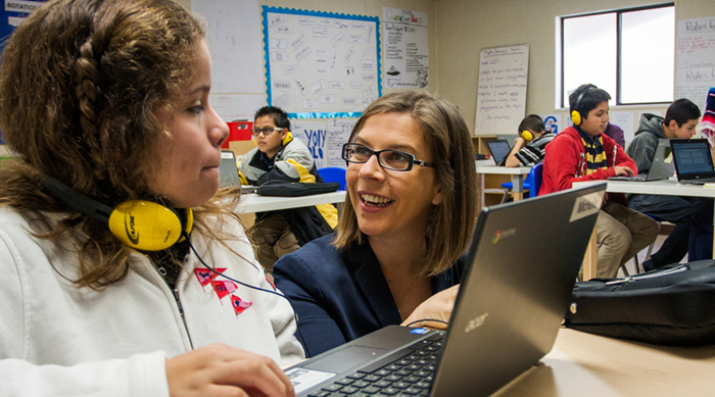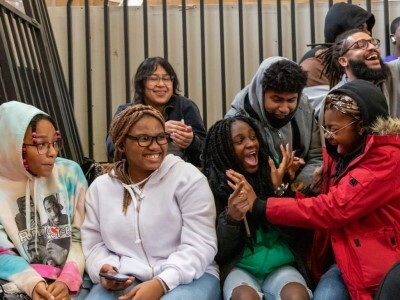Enabling Change
10 Principles to Move Your School toward Distributive Leadership
Topics

Next generation learning is all about everyone in the system—from students through teachers to policymakers—taking charge of their own learning, development, and work. That doesn’t happen by forcing change through mandates and compliance. It happens by creating the environment and the equity of opportunity for everyone in the system to do their best possible work.
Giving up control is the key to finding success as a leader, teacher and even parent in a blended school. First and foremost, you must trust the people around you.
The most intimidating part of leading and teaching in a blended learning school is not the technology. It is not the data crunching, either.
In fact, the scariest part of blending and personalizing learning is giving up control.
Giving up control is the key to finding success as a leader, teacher and even parent in a blended school. First and foremost, you must trust the people around you. For teachers, that means giving the right tools to students, and then trusting students to drive their learning. Parents must trust in this new paradigm for learning and trust in the school leaders.
We shouldn't be so worried about making mistakes—rather we should use them as stepping stones to greater learning and increased success.
But administrators may have the trickiest part to play—they must share the leadership role, and trust “their people”—their students, teachers, parents. This distributed leadership approach is a collaborative effort undertaken between people who trust and respect each other’s contributions. By using principles of distributed leadership, school administrators can empower people to make great decisions, learn from mistakes and reach new heights.
Here are my 10 guiding principles for blended learning schools moving to a distributive leadership structure. (They’re inspired by the awesome leaders and colleagues with whom I share this work!)
1. Remember: Everyone is a Novice & an Expert
Resist the urge to make some people knowers and other people learners. Everyone has something to learn, and everyone has something to contribute. Make this clear to all on the team and remind them often of this fact.
2. Embrace ALL Parts of Entrepreneurship
Educators love the idea of fostering entrepreneurship, but often forget that part of being an entrepreneur involves making mistakes. Taking leadership risks that sometimes end in failure is a natural way of learning to do better and reaching new heights. In fact, when you get something right, one brain synapse fires; but when you get something wrong, TWO synapses fire. So we shouldn’t be so worried about making mistakes—rather we should use them as stepping stones to greater learning and increased success.
3. Know the Vision & Share it Often
If people know where they are going, how they get there is irrelevant. Like a flight to Italy—you don’t really care what flight plan the pilot makes, just as long as you land there. Allow your teachers to create their own flight plans, but make sure often that YOU KNOW and THEY KNOW where they’re landing! At our school, we spend over a week talking about our vision; we then spend another week and a half mapping our path. People can map their own path once they are crystal clear about where they are headed.
4. Give People Voice and Choice
The choice on how to arrive at a location (see above) is vital to people truly believing in their work. If you have set the vision clearly, then people will choose whatever path is best for them and for students. Trust them to do so and check in on to find out what they need. When checking in, make sure you hear all voices. Giving “voice” doesn’t mean every decision is democratic, but it does mean that everyone gives input and all input is valuable. Ask yourself, “Have I heard from everyone?” If not, figure out a way to get more voices—or find out why folks aren’t talking!
5. Create Systemic Autonomy
To build autonomy and empower your team, you must have systems in place that support self-direction. Autonomy done well is not careless; it is thoroughly thought out, intentional, and sustained by the structured and systems you create. For example, rotate leadership responsibilities, like facilitating a school-wide meeting, so every person gets a chance to set the agenda and take responsibility for the conversation about the school and its needs. Another system might be setting up budget line items for each staff member. By giving some budget control to individual team members, they have the opportunity to buy what they need when they need it. Trusting that your staff knows what the organization needs empowers them, builds autonomy, AND distributes the leadership in the school community.
6. Hire Well
Don’t ever shortcut hiring! You are creating a team—get everyone involved—staff, parents, and students. Including all stakeholders in the hiring process ensures a shared responsibility and commitment to the school vision. Dynamics and culture will make or break specific projects. (If you want to know why, see number 4.)
7. Get Out of the Way: Don’t Micromanage!
Teachers are entrusted with the lives of children every day—a task none of us takes lightly. We expect them to protect, teach, and care for kids, so why is it so challenging to trust them with other decision-making responsibilities? As leaders, we must let our teachers step up, take control, make mistakes, course-correct, and manage their classroom budgets accordingly. We trust them with children; the other things are small in comparison!
8. Allow Opportunities for Assessment
A big part of distributing leadership means checking in, evaluating, reflecting, and assessing. We do this naturally with students, but often forget to do so with adults. Reflecting on strengths and finding opportunities to grow can happen often and with a kind-but-discerning eye on school vision and student success. Self-assessments, 360-degree evaluations, and feedback cycles are all part of assuring that people are doing what they can and are receiving the support they need.
9. Focus on Skill & Will
Help people on your team find their passion and make their mark. Provide training and opportunities, create individualized professional development plans, and create plenty of instances for stakeholders to share their expertise. Building a team of passionate experts is an intentional and ongoing project.
10. Celebrate Small Victories
Make success—big and small—visible and irresistible. People want to be recognized for their great work (even when they say they don’t). And by celebrating great work publicly, you will attract people to the success party (and the school). Everyone likes to be on a winning team, we all want to do what is best for kids, so make all of the great things that are working public!
This article would not have been possible without inspiration from my fellow innovation leaders (and NGLC grant recipients) Oliver Sicat, Liz Arney, and Jonathan Tiongco. Thanks for letting your brilliance rub off on me.
Learn More
K-12 Roundup of Tools and Resources: Distributed Leadership - Every day, teachers do the hard work of facilitating and supporting student learning. Teacher leadership has a wide and positive impact on students in schools that deeply value and build systems of shared, distributed leadership.
The Importance of Social Emotional Learning in K-12 Education - Also by Nicole Assisi. To build the skills needed for students to thrive in a blended learning environment, Thrive educators focus on Fostering Student Voice, Building Resilience, Generating Self Advocacy, and Teaching Self-Regulation. In short, socially and emotionally robust kids.
5 Best Practices for Reimagining Professional Learning This Year - How do we position aspiring next gen educators to be successful? Mirror next gen learning for students, position educators as agents of change, and enable educators to direct their learning.




